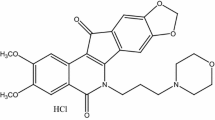Summary
Disposition studies in the same animals as those used for assessment of antitumour and toxic effects could increase understanding of the variation in response to cytotoxic drugs. Tissue and plasma levels of ThioTEPA and triethylenephosphoramide (TEPA) were measured to see if any correlation existed between them and the effects of the drug on a series of mouse colon tumours (MAC). The tumour panel included an ascitic form (MAC 15A), an anaplastic (MAC 13) and a well-differentiated (MAC 26) solid tumour, all grown subcutaneously.
The maximum tolerated dose of ThioTEPA was 20 mg kg-1 in females bearing MAC 13 and 15 mg kg-1 in males having MAC 15A or 26. The diverse growth characteristics of the tumour cell lines necessitated the use of different methods for assessment of response. After administration of the maximum tolerated dose, the greatest response was observed in MAC 26, in which a growth delay of 15 days — twice the doubling time of the tumour volume — occurred. ThioTEPA produced 58% inhibition of MAC 13 tumour weight, but MAC 15A was unresponsive.
One hour after intraperitoneal administration of ThioTEPA (20 mg kg-1), ratios of tissue to plasma concentration were 1.13, 0.87 and 1.17 in tumours and 0.80, 0.75 and 0.73 in spleens of mice bearing MAC 13, 15A and 26 respectively. These data show greater accumulation of drug in neoplastic than in normal tissues. The pattern of distribution of the metabolite was similar, but there was a lesser degree of tissue accumulation than by the drug. Concentrations of drug and metabolite in neoplastic tissues related to their protein content were 116.0, 126.3 and 183.3 μg ThioTEPA/g and 57.5, 83.1 and 78.6 μg TEPA/g in MAC 13, 15A and 26 respectively.
Combination of these chemosensitivity and pharmacokinetic data indicates that differences in response of these tumours to ThioTEPA cannot be explained by the availability of the drug and metabolite. The therapeutic effects of ThioTEPA cannot be predicted purely from a knowledge of drug and metabolite disposition.
Similar content being viewed by others
References
Craig AW, Fox BW, Jackson H (1959) Metabolic studies of [32P]-labelled triethylenethiophosphoramide. Biochem Parmacol 3: 42–50
Craig AW, Jackson H (1955) The metabolism of [32P]-labelled triethylenephosphoramide in relation to its anti-tumour activity. Br J Pharmacol 10: 321–325
Double JA, Ball CR (1975) Chemotherapy of transplantable adenocarcinomas of the colon in mice. Cancer Chemother Rep 59: 1083–1089
Double JA, Ball CR, Cowen PN (1975) Transplantation of adenocarcinomas of the colon in mice. J Natl Cancer Inst 54: (1) 271–275
Double JA, Bibby MC, Loadman PM (1986) Pharmacolinetics and anti-tumour activity of LM985 in mice bearing transplantable adenocarcinoma of the colon. Br J Cancer 54: 595–600
Double JA, Bibby MC, Mughal MA (1981) Increased therapeutic activity of ThioTEPA in experimental mouse colon tumours following nandrolone decanoate pre-treatment. Br J Cancer 44: (2) 305–306
Egorin MJ, Akman SR, Gutierrez PL (1984) Plasma pharmacokinetics and tissue distribution of ThioTEPA in mice. Cancer Treat Rep 68: 1265–1268
Haase P, Cowen DM, Knowles JC, Cooper EH (1973) Evaluation of dimethylhydrazine-induced tumours in mice as a model system for colorectal cancer. Br J Cancer 24: 530
Lowry OH, Rosebrough NJ, Farr AL, Randall RJ (1951) Protein measurement with the Folin Phenol Reagent. J Biol Chem 193: 265–275
McDermott BJ, Double JA, Bibby MC, Wilman DEV, Loadman PM, Turner RL (1985a) Gas chromatographic analysis of triethylenethiophosphoramide and triethylenphosphoramide in biological specimens. J Chromatogr (Biomed Appl), 388: 335–345
McDermott BJ, Double JA, Bibby MC, Loadman P, Turner RL (1985b) Pharmacokinetic studies of ThioTEPA in patients and mice and effect of co-administration of nandrolone decanoate. Br J Cancer 52: 458
Nadkarni MV, Goldenthal EI, Smith PK (1957) The distribution of radioactivity following administration of triethylenephosphoramide-P32 in tumor-bearing and control mice. Cancer Res 19: 713–718
Rowland M, Tozer TN (1980) Clinical pharmacokinetics: concepts and applications. Philadelphia, Lea & Feabiger, pp 34–39
Ruddon RW, Mellett LB (1964) Distribution of [14C]-labelled ThioTEPA (NSC-63396) and its metabolites in normal and tumor-bearing rats. Cancer Chemother Rep 39: 7–13
Soloway MS, Ford KS (1983) ThioTEPA-induced myelosuppression. Review of 670 bladder instillations. J Urol 130: 889–891
Sugiura K, Chester Stock C (1955) Studies in a tumor spectrum. III. The effect of phosphoramides on the growth of a variety of mouse and rat tumors. Cancer Res 15: 38–50
Turner R (1981) The value of anabolic sterols for patients receiving chemotherapy. Exc Med Int Cong Ser. No. 9, Amsterdam, p 1
Workman P (1985) The role of preclinical pharmacokinetics in phase-I trials. Br J Cancer 52:(3) 412
Author information
Authors and Affiliations
Rights and permissions
About this article
Cite this article
Bibby, M.C., McDermott, B.J., Double, J.A. et al. Influence of the tissue distribution of ThioTEPA and its metabolite, TEPA, on the response of murine colon tumours. Cancer Chemother. Pharmacol. 20, 203–206 (1987). https://doi.org/10.1007/BF00570485
Received:
Accepted:
Issue Date:
DOI: https://doi.org/10.1007/BF00570485




